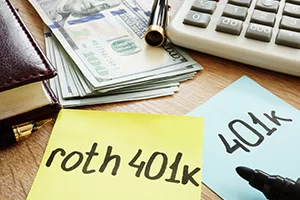
Business Advisory
Business Advisory Services
Everything you need to help you launch your new business entity from business entity selection to multiple-entity business structures.

Everything you need to help you launch your new business entity from business entity selection to multiple-entity business structures.

Designed for rental property owners where WCG CPAs & Advisors supports you as your real estate CPA.

Everything you need from tax return preparation for your small business to your rental to your corporation is here.

Fermentum aliquet amet
tristique purus vitae. Adipiscing
id rhoncus quisque mauris amet.
Table Of Contents

 Summer is tax planning time and we get a lot of questions about solo 401k contributions, and whether they should be Roth 401k contributions or traditional (pre-tax) 401k contributions. Our general answer is Roth for a few reasons.
Summer is tax planning time and we get a lot of questions about solo 401k contributions, and whether they should be Roth 401k contributions or traditional (pre-tax) 401k contributions. Our general answer is Roth for a few reasons.
Before we get into that, let’s review a couple of things. First, when we say Roth 401k we are not talking about Roth IRAs. We truly are talking about a post-tax contribution to a 401k plan. 401k plans and IRAs are totally different.
Next, unlike a Roth IRA, a Roth 401k does not have income limits. So, while you might be phased out based on income from a Roth IRA (modified adjusted gross income cannot exceed $214,000 for the 2022 tax year), you can make a zillion dollars and contribute to a Roth 401k.
Wait, there’s more! You can contribute $20,500 for the 2022 tax year into a Roth 401k plus another $6,500 if you are 50 or older. This is in stark contrast to a Roth IRA which is $6,000 + $1,000.
Most 401k plans, both solo 401k plans and full-blown big-biz 401k plans, have two “accounts.” One for pre-tax or traditional 401k contributions, and another for Roth 401k contributions.
Quick recap- Roth 401k contributions have higher limits and do not have any income phaseouts. Let’s not forget about tax-free growth.
So… Roth or pre-tax… which do you use?
Two arguments abound when considering a pre-tax 401k contribution. The argument goes like this- your retirement tax rate will be lower than your wage-earning tax rate. For those in the 32%, 35% or 37% marginal tax brackets, this is likely true. However, those earning big bucks probably continue to earn big bucks during retirement from investments, real estate, consulting, etc.
 The other argument is about the free loan from the IRS. If you contribute $27,000 to your pre-tax 401k and you are in the 32% marginal tax bracket, you just put $8,640 in your pocket ($27,000 x 32%). Sure, at some point the IRS wants it back when you withdraw it during retirement, and will tax the original contribution plus whatever you earned on it. But this falls into the let’s worry about next time, next time category.
The other argument is about the free loan from the IRS. If you contribute $27,000 to your pre-tax 401k and you are in the 32% marginal tax bracket, you just put $8,640 in your pocket ($27,000 x 32%). Sure, at some point the IRS wants it back when you withdraw it during retirement, and will tax the original contribution plus whatever you earned on it. But this falls into the let’s worry about next time, next time category.
As such, the second argument is about using the IRS’s money to build additional wealth. You take your $8,640 and do something good with it. Yeah, this sort of works. $8,640 annually might not move the needles much on your wealth building strategies. You would need $8,640 x 15 years at 6% rate of return just to afford a down payment on an average rental property.
Rather, most wealth is built with after-tax dollars. The leveraging of the IRS free loan concept sounds great on paper until you gain perspective on the size of the lever.
Another side argument is completely avoiding state income taxes by reducing your state income and therefore income tax with 401k contributions during your wage-earning years, and then establish residency in a tax-free or a tax-friendly state during retirement. We talk about this in our tax reduction strategies blog post.
The theories above make sense; however, we ask a basic question- is it easier to pay taxes during your wage-earning years or during retirement? Sure, it depends how much you withdraw during retirement. Please consider that to spend $150,000 during retirement, you might have to withdraw upwards of $180,000 to account for the income taxes.
During your wage-earning years you might have the ability work a little harder to pay for taxes now. Pick up an extra shift. Close an extra deal. Get a few more tax returns out of the door if you are a tax accountant. Whatever it takes, right? During your retirement years, especially mid-70s or older, you pay taxes with retirement savings (or at least it feels like you do depending on your cash sources).
Also, keep in mind that your primary objective in life is to build wealth. Your second objective is to save taxes, and what a lot of people forget about is saving taxes is not done in a vacuum or just one year; it is done over your entire lifetime.
Here’s another angle to consider- you can delay required minimum distributions (RMDs) with a 401k plan. At the age of 72, you must start withdrawing money from IRAs and “remnant” 401k plans. However, there is a special rule for 401k plans-
You can delay RMDs. So, you could roll all your retirement accounts into a 401k plan at Wal-Mart, hand out carts and avoid having to take required minimum distributions. This gets tricky when you are self-employed since you would need to substantially work for another company and have your retirement money in their 401k plan (and now have a boss).
Then again, if you have mostly Roth 401k contributions, you don’t really care about avoiding RMDs since this is generally tax-free withdrawals. Keep reading!
Our first recommendation is to always defer to your financial advisor. He or she might have strong opinions one way or another, and are also in charge of your financial plan
But if you want our opinion, then here it is-
If you are working for a company with decent matching, then split your 401k contributions 50%-50% between Roth and pre-tax.
If you are self-employed, then put 100% of your contributions into the Roth component of your 401k plan, and then another 25% of your salary into the pre-tax component as a discretionary company contribution (sometimes loosely referred to as a profit-sharing contribution).
For example, if you are a business owner paying yourself $60,000 in salary, you could contribute $20,500 into your Roth 401k and another $15,000 ($60,000 x 25%) into the pre-tax 401k for a total of $35,500.
This is a nice way to get the best of both worlds. Pay taxes now, and enjoy tax-free growth on one hand. And on the other hand, get some tax deferrals. Win win!
Sidebar- a lot of financial advisors do not like 401k plans because they cannot earn a fee from managing those assets. If they are worth their salt, they will find a way to charge a flat fee or an hourly fee, and you’ll be happy to pay it for sound advice.
Jason Watson, CPA is a Senior Partner of WCG Inc., a business consultation and tax preparation CPA firm located in Colorado Springs, and is the author of Taxpayer’s Comprehensive Guide on LLC’s and S Corps which is available online and from mostly average retailers.

Learn about important tax deadlines, document due dates, and other business tax return info.

Learn about important tax deadlines, document due dates, and other business tax return info.
Table Of Contents

Lorem ipsum dolor sit amet, consectetur adipiscing elit, sed do eiusmod tempor incididunt ut labore et dolore magna aliqua.

Lorem ipsum dolor sit amet, consectetur adipiscing elit, sed do eiusmod tempor incididunt ut labore et dolore magna aliqua.
Did you want to chat about this? Do you have questions about Roth 401k Versus Traditional 401k? Let’s chat!
The tax advisors and business consultants at WCG are not salespeople; we are not putting lipstick on a pig expecting you to love it. Our job remains being professionally detached, giving you information and letting you decide within our ethical guidelines and your risk profiles.
We see far too many crazy schemes and half-baked ideas from attorneys and wealth managers. In some cases, they are good ideas. In most cases, all the entities, layering and mixed ownership is only the illusion of precision. As Chris Rock says, just because you can drive your car with your feet doesn’t make it a good idea. In other words, let’s not automatically convert “you can” into “you must.” Yes, it is fun to brag about how complicated your world is at cocktail parties, but let’s not unnecessarily complicate it for the bragging rights.
We typically schedule a 20-minute complimentary quick chat with one of our Partners or Senior Tax Professionals to determine if we are a good fit for each other, and how an engagement with our team looks. Tax returns only? Business advisory? Tax prep, and more importantly tax strategy and planning?
Should we need to schedule an additional consultation, our fee is $250 for 40 minutes. Fun! If we decide to press forward with a Business Advisory or Tax Patrol Services engagement, we will credit the consultation fee towards those services.

Taxes are complicated. We make them simple. Get in touch with a pro here at WCG!

Everything you need to help you launch your new business entity from business entity selection to multiple-entity business structures.

Designed for rental property owners where WCG CPAs & Advisors supports you as your real estate CPA.

Everything you need from tax return preparation for your small business to your rental to your corporation is here.

Fermentum aliquet amet
tristique purus vitae. Adipiscing
id rhoncus quisque mauris amet.
